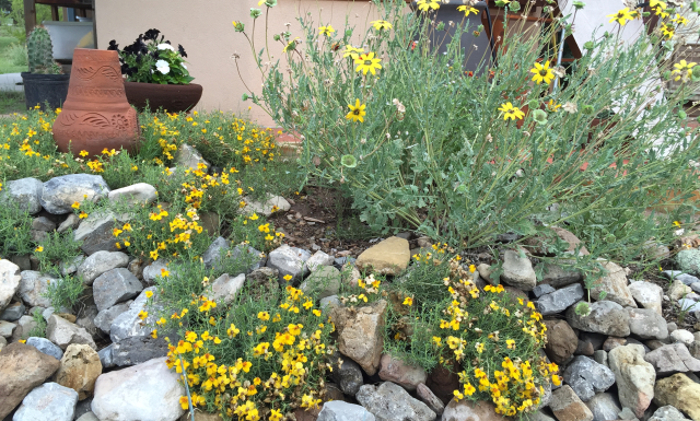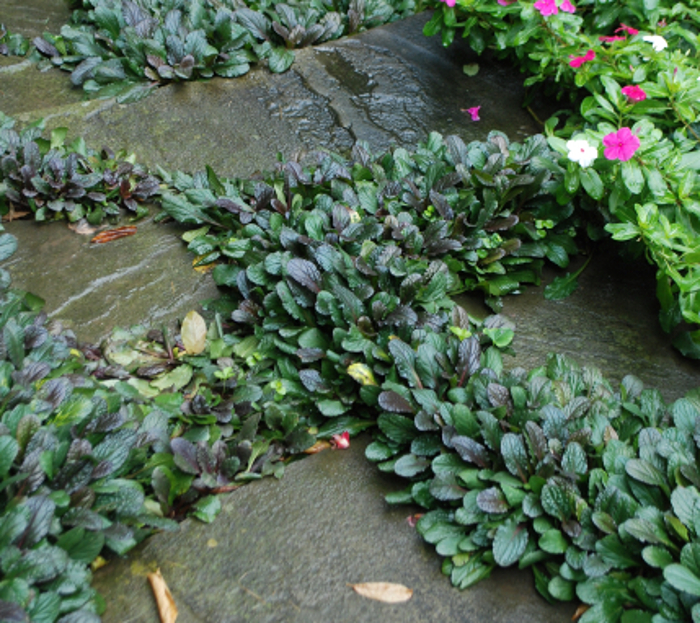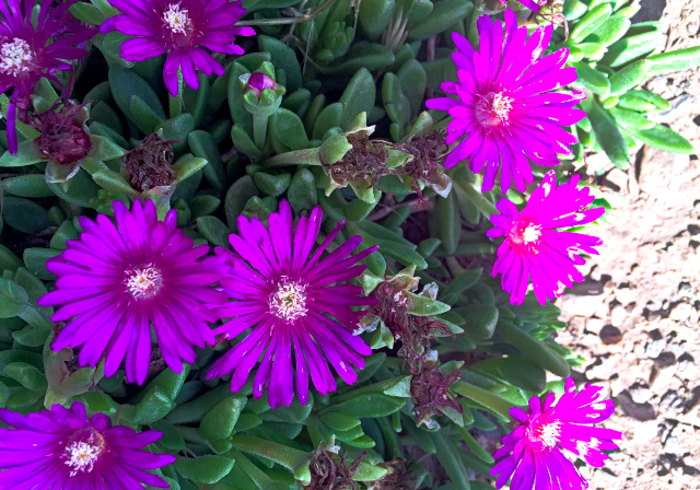Groundcovers might not be as sexy or exciting to plant as some ornamentals, but the low-growing plants are useful and can really add to a xeric garden’s look and function.

Prairie zinnia covers ground and rocks. Anything that grows in rocks gets by with little water!
Here are a few reasons and ways to use groundcovers:
Water savings: erosion control. On garden slopes, a low-growing groundcover slows the flow of water. Use one that’s relatively drought tolerant and the plant absorbs enough water from the flow to get by. An added bonus – slopes can be difficult to mow, and a low-growing groundcover needs less maintenance.
Water savings: mulch effect. Groundcovers cool the soil below and retain some moisture, which can work as a sort of living mulch under a tree or other plant that needs cooler roots.
Turf alternative: Groundcovers typically are less invasive and easier to control than grass, especially between flagstone or other steps.

Ajuga between flagstones in a private Atlanta garden. It creates a sort of woodland look.
Weed control. Once a groundcover blankets an area, weeds have a harder time growing in the same spot. It might not entirely eliminate them, but eventually weed seeds have a harder time getting into covered soil and receive less light.
Design element. Groundcovers can add color, year-round interest and an area of low growth in the foreground of a design or near paths.
Creeping thyme (Thymus ‘Pink Chintz’)
This is an excellent choice for filling in around flagstone steps or any area that takes foot traffic (see link above). In fact, several thyme varieties are considered steppable. Creeping thyme does fine with low water once it’s established, but if it receives more water, it grows more rapidly, which might help to fill in an area.
Ice plant (Delosperma)
The flowers of ice plants are delicate and bright, coming in yellow, bright pink or salmon and rust colors. Although some varieties of ice plant need a little more water than others, most can get by in xeric rock gardens. Ice plant is a rapid spreader and easy to maintain. If it grows outside the area you intend, just clip it off. Or pull up a stalk and its roots and move it to another spot in your garden.

Purple iceplant in a bed on the northside of the home.
Perky Sue (Tetraneuris scaposa)
Although Perky Sue might not technically be a groundcover, it can spread enough to add floral color and evergreen foliage. Other names include Hymenoxys scaposa, bitterweed, and narrow four-leaf nerve daisy. It’s also similar to the Angelita daisy (T. acaulis).

Perky sue has silver-like foliage and yellow daisy flowers.
Prairie zinnia (Zinnia grandiflora)
Also called desert zinnia, this is a favorite rock garden groundcover of mine. It has tiny, thread-like leaves and bright yellow flowers. Most of all, it spreads from the previous year’s plant; you simply remove the spent foliage as the weather warms and you see new green beneath the old. It can spread up to 6 or 10 feet.

Delicate, spreading and xeric. The prairie or desert zinnia.
Plumbago (Ceratostigma plumbaginoides)
The best part of plumbago is its fall color. The purple flowers typically bloom in early fall and then the leaves redden. Plumbago also does best in shade or part (afternoon) shade in warmer areas.

Veronica is another low-spreading groundcover for rock gardens. A Perky Sue bloom is peeking out on the left — in March!
All of these groundcovers are perennial and hardy to zone 6 or cooler. Groundcovers can require some patience or money. For carpet-like coverage, you either have to plant many of them fairly close together, or ideally space new plants according to planting instructions and wait for them to fill in.
 |
Author Teresa Odle - Published 12-10-2020 |
